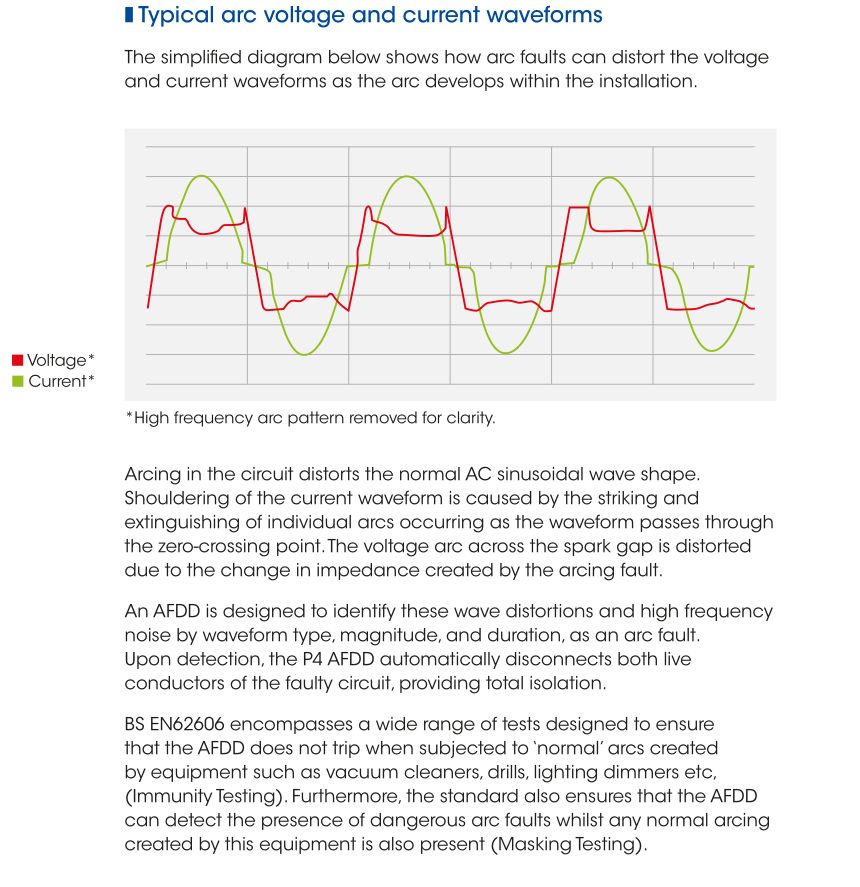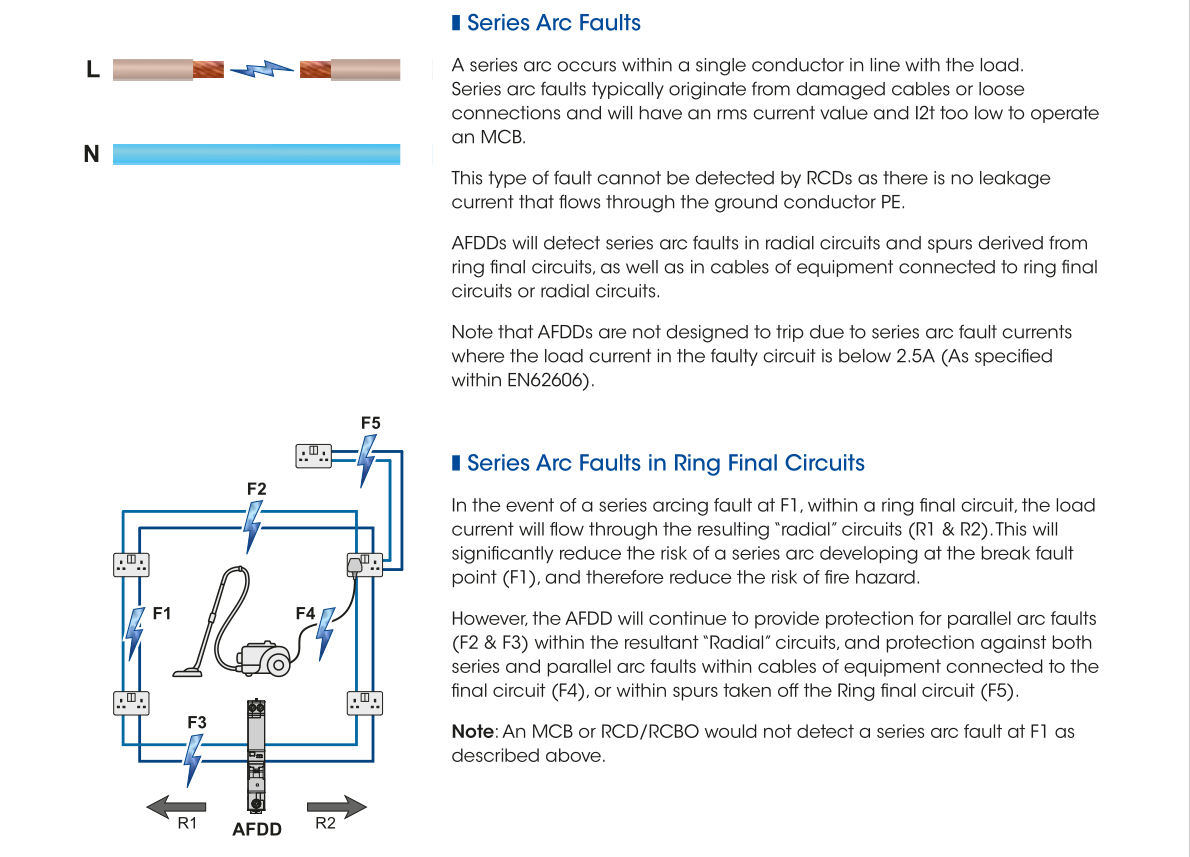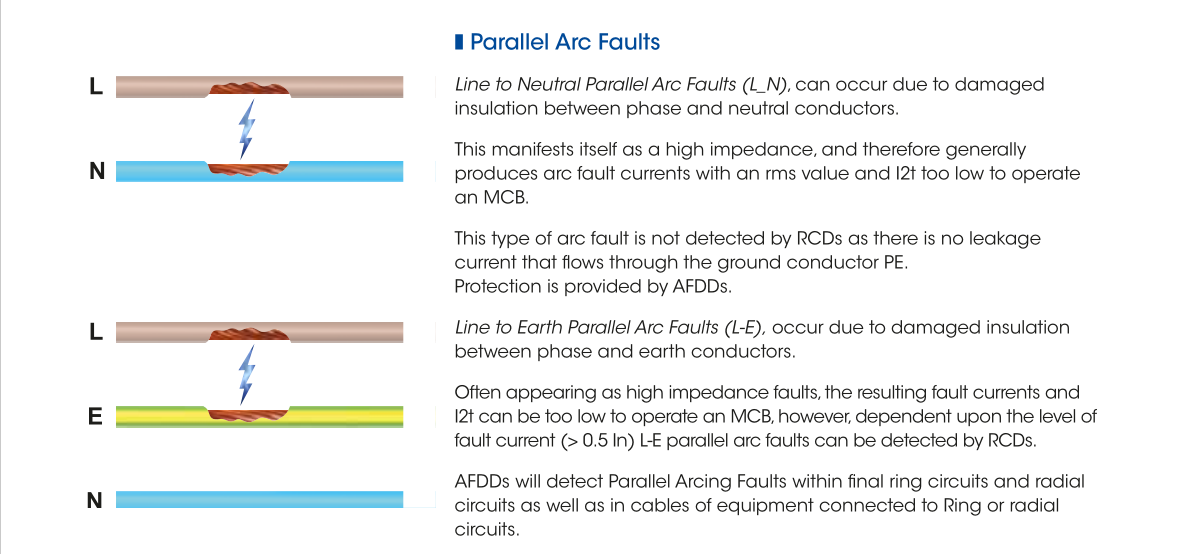The GFAD1-50 series of combined AFDD &RCBO - Quality approved combined AFDD &RCBO provides the highest degree of protection, safeguarding final circuits against the effects of:Over CurrentResidual CurrentArcing FaultsOver VoltageOver Voltage ProtectionAFDDs can also......
The GFAD1-50 series of combined AFDD &RCBO provides the highest degree of protection, safeguarding final circuits against the effects of:
Over Current
Residual Current
Arcing Faults
Over Voltage
Over Voltage Protection
AFDDs can also mitigate the risk fire caused by faults within the whole electrical Installation, both within the fixed wiring and the cabling of equipment connected to it.
What is an arcing fault?
An arcing fault is defi ned as a “dangerous unintentional arc” within an
electrical circuit which has the intensity and duration to cause localised
heating at the point of the arc.
This high intensity heating can result in localised burning that over
time can generate temperatures exceeding 6000°C, suffi cient to burn
surrounding insulation and eventually allowing a fi re to develop.
Depending upon the nature of the fault, an arcing fault may not develop
immediately, only becoming established over a long period of time
as carbonisation of the surrounding insulation material creates the
conditions for the arc to develop.
Potential causes of arcing faults.
Arcing faults can occur due to several reasons, ranging from poor
installation or accidental damage to cabling and equipment, to
deterioration of the cable over time due to external factors. These faults
can occur within the fi xed cabling installation, or on portable equipment
connected to the fi xed wiring installation.
Electrical arcing faults may be caused by (but not limited to):
• Kinks or breaks in fl exible appliance leads
• Conductor/insulation damage caused by drilling
or construction work
• Incorrect wiring stripping
• Defective plugs and sockets
• Rodents chewing cables
• Damage to cable insulation (exposed or frayed wires)
• Dirty or worn electrical contacts
• Impurities such as corrosion or dust
• Appliance failure
• Poorly maintained electrical systems
• Trapped or Crushed Cables*
• Insulation deterioration due to:
o Incorrect bending radius of cables
o UV deterioration
o Thermal overload
• Loose terminations*
* Note: AFDD’s will detect arcing but not high resistance connections,
or trapped insulation.

How an AFDD works in detecting dangerous arcing faults.
An AFDD uses microprocessor-based technology to continuously monitor
the electrical circuit, identifying unintentional arcs caused by broken or
damaged cables or poor connections. They can differentiate between
“dangerous arcing” and “normal arcing” caused by switching events or
operation of motor loads.
To achieve this, the AFDD analyses the duration and irregularity of the arc
waveform itself. In this way, the AFDD can distinguish between dangerous
arc faults and arcing caused by normal operation of equipment such as
vacuum cleaners, drills, lighting dimmers etc.
Dangerous arcing consists of a long duration arc which becomes
established and creates suffi cient energy to cause localised ignition, whilst
arcing associated with the normal operation of equipment is of much
shorter duration and would not activate the AFDD.

Series and parallel arcing faults.
Arcing Faults can be classifi ed as ‘Series’ or ‘Parallel’.
In general, series arc faults are localised, and fault current is limited by
the connected load, thus remaining within the current rating of upstream
overload protective devices.
Due to the arcing current being in series with the load series, arc fault
currents are signifi cantly lower than those which can be generated by
parallel arc faults.
Parallel arc faults will signifi cantly increase the circuit current, but due to
the inherent high impedance, may not reach the short circuit current
value which would cause operation of an upstream overcurrent protection
device.


The Wiring Regulations BS7671 provides for several levels of protection
against fi re within electrical installations, ranging from the implementation
of basic protection, by defi ning wiring practices, insulation of live parts,
and the inclusion of barriers and enclosures, to the use of fault protection
devices such as MCB’s and RCDs, and more recently the requirement to
install Surge Protection within designated areas.
In addition, there are 2 main areas within BS7671 which relate specifi cally
to the installation of AFDD’s:
The GFAD1-50 series combined AFDD & RCBO.
The GFAD1-50 series combined AFDD & RCBO offers the ultimate
protection for 230V distribution circuits against the effects of:
1. Overcurrent faults (Overload and Short circuit)
2. Residual current faults (30mA type A)
3. Series & Parallel arcing faults
4. Prolonged overvoltage faults
They are designed for integration within the GF range of distribution
boards and are fully interchangeable with the GF range of 6kA single
module MCBs and RCBOs.
Available in current ratings of 6-50A, incorporated within a single module width.
The device combines a microprocessor based AFDD with a 1P+ Switched
Neutral RCBO, incorporating a 30mA class A RCD and a 6kA MCB, and is
suitable for use on TN-S, TN-C-S & TT network systems.
The switched Neutral pole makes the device suitable as a means of double
pole isolation, and is particularly appropriate for installations within TT
Earthing Systems where it is necessary to disconnect all live conductors to
achieve safe isolation of individual circuits (BS7671:2018 Regulation 462).
Lewden AFDD RCBOs are suitable for use 230V 50Hz supplies. They are not
designed for use on DC networks.